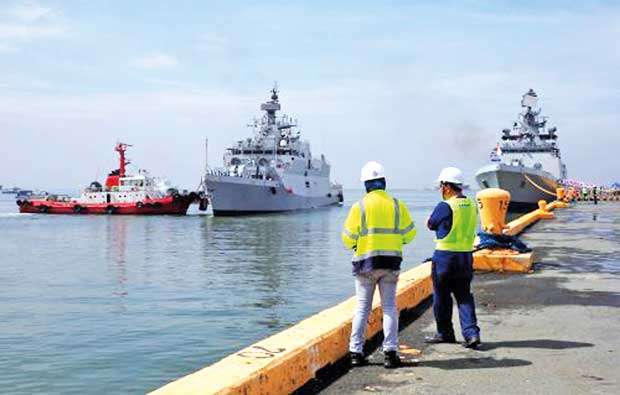01 May 2018 - {{hitsCtrl.values.hits}}

 Under the leadership of Prime Minister Narendra Modi, India has advanced its ‘Act East’ policy, an upgraded version of the 1990s ‘Look East’ policy. This new approach encompasses a more robust political and security engagement with Asia.
Under the leadership of Prime Minister Narendra Modi, India has advanced its ‘Act East’ policy, an upgraded version of the 1990s ‘Look East’ policy. This new approach encompasses a more robust political and security engagement with Asia.
As India’s economic and geopolitical importance has grown, its pursuit of economic security has moved beyond the country’s immediate geographic realm (namely the subcontinent and the Indian Ocean region). New Delhi is now increasingly fostering economic, political and diplomatic bonds with selected East Asian states and with the United States.
India today is less constrained by its traditional non-alignment principles in international relations. It is more engaged in the realpolitik of the world and as a more proactive actor in Asian security issues. Its security agenda has been particularly attentive to China’s recent activities in the South China Sea.
India’s main security concern in the South China Sea is the guarantee of freedom of navigation — something that Indian diplomatic and military officials have consistently expressed to China in several forums. India has promptly responded to recent Chinese activities affecting the freedom of navigation in the South China Sea by working with actors outside Southeast Asia (mainly the United States and Japan) and through its naval strategy.
And yet, from unresolved border issues to an increasing Chinese presence in the Indian Ocean region itself, the competitive aspects of the India-China bilateral relationship conceal the extent to which economic forces are moving the two countries towards cooperation. India and China’s shared economic interests include economic integration through the Regional Comprehensive Economic Partnership and coordination within the BRICS (Brazil, Russia, India, China and South Africa) forum.
But China’s conciliatory economic policy towards India comes as Beijing is pushing its maritime consolidation in the South China Sea. This consolidation includes the upgrade of China’s facilities in the Spratly Islands and China’s dismissal of the 2016 Permanent Court of Arbitration ruling.
Hence, India must carefully balance its economic interests with its security concerns in its relations with China. New Delhi’s responses to recent events in the South China Sea — in the form of a greater naval presence as well as modest energy exploration activities — are constrained by its fundamental strategic objectives. These objectives involve avoiding escalations that might have an impact on its security, maintaining growing levels of trade with its partners, especially China and developing a naval strategy that is fully ‘Indo-Pacific’ in nature.
Security threats continue to dominate the mindset of India’s policy circles, from terrorism and border instability on the subcontinent to China’s recent economic and naval advances in the Indian Ocean region.
In the South China Sea, India might soon decide whether or not to project more naval power, even though this maritime region is still considered a secondary area in its maritime strategy. But India’s aspiration to become a major power in East Asia, among other policies to consolidate its reputation as a proactive member of the maritime community, means the country needs to upgrade its naval strategy to fully address the importance of the South China Sea for India’s economic security.
India’s future policy towards the South China Sea might not necessarily involve the containment of China in tandem with the United States, Australia and Japan, as some are now suggesting. Nor need it involve freedom of navigation operations. Rather, New Delhi’s approach to the South China Sea may come in the form of upgraded security cooperation to address non-traditional security threats, for example through humanitarian assistance and disaster relief.
Indian diplomacy seeks a delicate balance whereby New Delhi will continue to moderately develop cooperation with the navies of the United States, Japan and ASEAN countries to address China’s assertiveness in the South China Sea. But it will only do so to the extent that such regional coordination does not affect New Delhi’s core economic or other strategic interests, particularly in the Indian Ocean region.
New Delhi’s long-term maritime development strategy should include more investment in Southeast Asian maritime infrastructure, efforts to improve port capacity with partners and allies alike and the construction of a robust commercial fleet at home. Its short- and mid-term priorities with China must include searching for mechanisms to foster maritime cooperation and to guarantee freedom of navigation in the South China Sea. These are outcomes that are possible to devise and operationalise, as the first China-India Maritime Affairs Dialogue proved in 2016.
At the end of the day, the relationship between India and China still encompasses relevant security priorities for India beyond the South China Sea. These may lead both countries onto the path of bilateral cooperation and invigorate India’s ‘Act East’ policy in the years ahead.
(Ulises Granados is Associate Professor and coordinator of the Asia Pacific Studies Programme at the Instituto Tecnologico Autonomo de Mexico (ITAM). This article is based on the author’s paper published in Asia & the Pacific Policy Studies, ‘India’s approaches to the South China Sea: priorities and balances’)
18 Nov 2024 58 minute ago
18 Nov 2024 1 hours ago
18 Nov 2024 2 hours ago
18 Nov 2024 6 hours ago
18 Nov 2024 7 hours ago